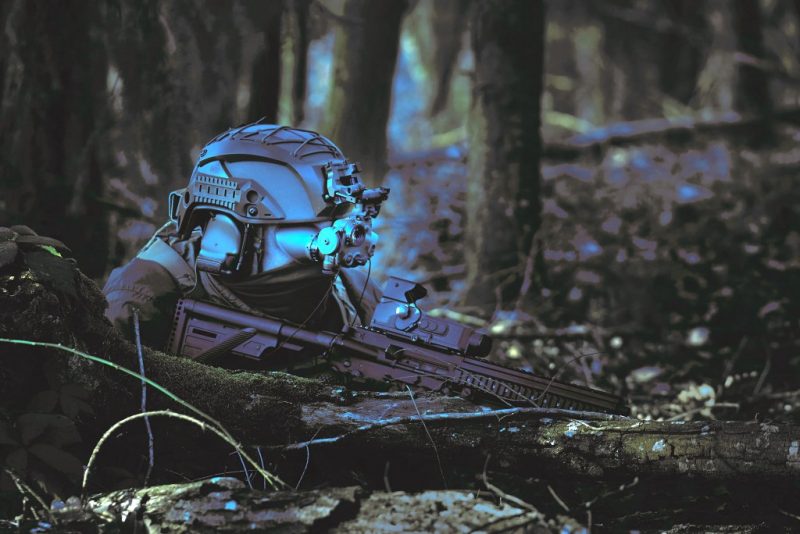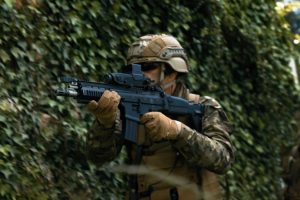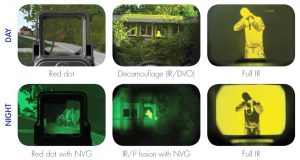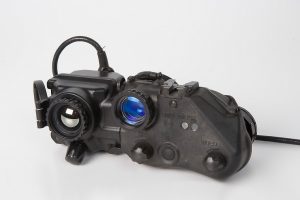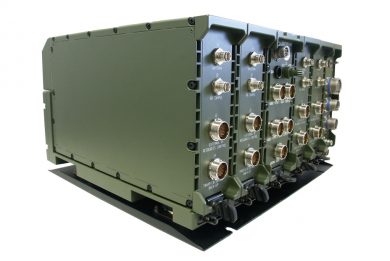Testing Thales dismounted soldier night vision optronics
Early before Eurosatory EDR On-Line was given the opportunity to test some of the newest Thales soldier night vision systems during a visit to Saint-Héand, the company facility specialised in optics and dismounted soldier optronics, where beside the latter the renowned Angenieux professional cinema lenses, used in the production of most movies, are manufactured.
In late 2021 Thales launched a new day-night rifle sight, the XTRAIM, which couples a daylight channel with an uncooled thermal (TI). While the latter is obviously used at night, it can be also used in daylight, something that is not possible with image intensification (I2) systems. Not only, its peculiar optical architecture allows the soldier wearing I2 night vision goggles to look through the sight, fusing de-facto II and TI at night, while in daylight the fusion is between visual and thermal.
EDR On-Line reported on the XTRAIM in December 2021, and readers looking for technical data can retrieve that story by clicking HERE
The small size of the sight, less than 170 mm long, and its contained weight, under 530 grams with the two CR123 batteries, do no add much to the soldier’s burden when handling his assault rifle, and do not alter the centre of gravity. Considering typical shooting distances, the 1.6 MOA red dot proves to have the right dimensions to deal with a typical human target at a few hundreds meters, the XTRAIM having a x1 magnification.
The first scenario to which we were confronted was in full daylight, a SWAT team being required to acquire targets inside a building. In full light the eyes’ pupils tend to contract as much as possible, to optimise daytime vision, however this prevents from seeing what is happening in dark areas, such as inside the building. Looking in the room through the XTRAIM in daytime mode it was impossible to see any human presence, as all appeared pitch black. Things changed completely once the thermal mode was switched on, as the personnel in the room became immediately visible, their bright shape contrasting with the dark background, while keeping an eye on the external scenario, the system allowing sighting keeping both eyes open, the 14° field of view proving sufficient to easily acquire the target while monitoring the situation around it. The operation was repeated more than once, setting the XTRAIM either in Full IR mode or in Contour mode, the latter providing only the peripheral shape of the target,
Ergonomy was good, although obviously at first a minimum of familiarisation with the sight commands was needed.
The second scenario was a night one, the task being to find a target in a rural area. As said the XTRAIM can be used also when wearing NVGs, and these we worn, which provided a general view of the landscape, but definitely didn’t allowed to pick-up a human being hiding in the night. Scanning the ground ahead of us looking through the XTRAIM in thermal mode it was relatively easy to notice the signature of a body, here too the 14° FoV proving adequate to the task, sufficiently wide for search and narrow enough for aiming. The thermal channel proved to be key in unmasking the targets in both scenarios, giving an edge to the operator, and this capability will soon be available, Thales planning to start delivering its XTRAIM sight in 2023.
Using an NVG, in conjunction with the XTRAIM thermal sight, proved very effective. However this is not the first time Thales couples TI with another channel to improve performances. Over one decade ago the company unveiled an NVG that possesses both I2 and TI channels, the Minie-DIR, and although not a new product, it was interesting testing it at night in the central France countryside. A four-people “recce patrol” was launched to search for a friendly individual that was known to be lying relatively close to a dirt track. Four different NVGs were issued, and EDR On-Line had the chance to get the Minie-DIR, which is a Minie-D NVG fitted with an IR module. Once the helmet harness is correctly set the typical unbalance felt due to the weight of the NVG is relatively reduced, as the Minie is pretty compact, only 77 mm depth, the weight of the “DIR” version being 490 grams with batteries.
The I2 channel exploits a single tube of the latest generation; compared to NVGs fitted with older tubes tested in the past the image quality is definitely much better. A single-tube system, it of course lacks the stereoscopic effect of a two-tube NVG, but the image quality of latest generation intensification tubes allows walking easily, at least on a relatively simple ground. The image captured and amplified by the tube is split on two oculars, and provides a 51° field of view. This wide FoV avoids the user from totally losing peripheral view, and it is incredible how much a 10° extra FoV makes it much more comfortable to move around, even in a group of people walking close to each other. Moving the head right and left to cover the full frontal arc, the TI FoV is 35.8° diagonal thus narrower than that provided by the I2, the thermal signature of the person we were looking for showed up immediately when he came in sight. The Minie-DIR was set on Contour mode, which allows exploiting I2 for walking and TI for searching, and also helps in identifying the target. Of course none of those who were wearing basic I2 NVGs picked up the target. Thales underlines that the system modularity, the IR module that weighs 120 grams can be installed on any Minie-D, allows to provide it only a limited number of soldiers in the fire team, thus reducing cost.
Coupling the two technologies, image intensification and thermal imaging, is more and more common, and it was good being able to verify in real on the field the advantages of that solution, and to witness the progress made in soldiers optronics by Thales.
Photos courtesy Thales

